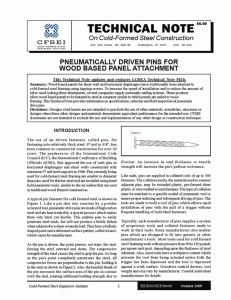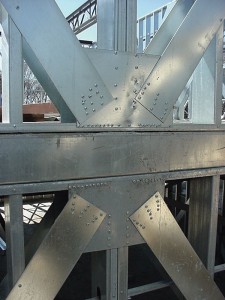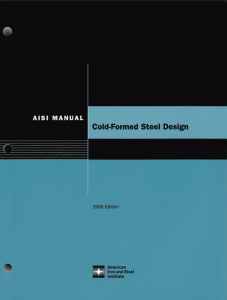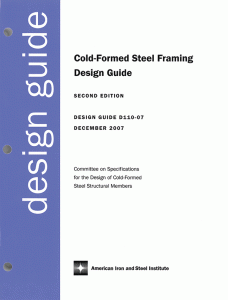When the author first started his structural engineering career in the 1980s, common cold-formed steel applications in buildings were primarily limited to steel roof and floor deck, interior non-load bearing partition walls, and curtain wall framing; in other words, secondary members. As a structural engineer designing buildings, one could rely on manufacturers’ literature, such as steel deck catalogs, or delegate the design of these cold-formed steel applications to contractors or specialty structural engineers through performance specifications. Significant experience in cold-formed steel framing design was not required.
With the increasing use of cold-formed steel framing as the primary structure for roof, floor, and load-bearing walls in buildings with multiple stories (mid-rise construction), experience in cold-formed steel framing is now required. Unfortunately, it is often the case that very little exposure to cold-formed steel design occurs in undergraduate education. The fundamentals of structural steel behavior and design often focuses on hot-rolled steel. The reference document of choice is the American Institute of Steel Construction (AISC) Steel Construction Manual, which includes the AISC Specification for Structural Steel Buildings, which does not address cold-formed steel. It was not until graduate school, and later while working for an engineering firm, when the author learned about cold-formed steel behavior and design.
For many, cold-formed steel design information that is practical, clear, and easy to use can be difficult to find. Thankfully this void in information has been recognized by the cold-formed steel framing industry and is being addressed through the efforts of the Cold-Formed Steel Engineers Institute (CFSEI) and the American Iron and Steel Institute (AISI). The mission of CFSEI, an organization composed of primarily structural engineers, is “to enable and encourage the efficient design of safe and cost effective cold-formed steel (CFS) framed structures.” This mission is being partially accomplished through the development of Technical Notes on Cold-Formed Steel Construction, more commonly known as Tech Notes (Figure 1). Tech Notes address fundamental design issues as well as frequently asked questions pertaining to the design and construction of cold-formed steel structural members and connections. In addition to providing discussion of the design concepts and methods, Tech Notes typically illustrate the design with numerical example problems, and some include design aids. Tech Notes are written by structural engineers experienced in cold-formed steel design, and thoroughly reviewed by members of the CFSEI Technical Review Committee. The authors and reviewers volunteer their time to fulfill the mission of CFSEI.
For the experienced hot-rolled structural steel design engineer, cold-formed steel member design does not differ dramatically from hot-rolled steel design, other than the consideration for local buckling, which can be easily avoided in hot-rolled steel design, and distortional buckling, especially with the availability of computer software programs and design catalogs. However, connection design is often the major stumbling block for an engineer transitioning to cold-formed steel design. Different fasteners, including screws (Figure 2) and power-actuated fasteners (PAFs), are more commonly used in cold-formed steel framing. Eccentricities resulting from the singly-symmetric and point-symmetric member sections and single angle connections are normal design considerations. To assist the engineer, the following CFSEI Tech Notes have been developed:
- Screws for Cold-Formed Steel-To-Wood and Wood-To-Cold-Formed Steel Attachments (F101-12) reviews the design provisions of the AISI North American Specification for the Design of Cold-Formed Steel Structural Members, the National Design Specification® for Wood Construction (NDS®), and the APA-The Engineered Wood Association (APA). It also discusses design and detailing of the connection of cold-formed steel members to wood structural supports, and the attachment of wood structural panels and sheathing to cold-formed steel members.
- Evaluation of Screw Strength (F701-12) provides design guidance for the evaluation of the screw itself when subjected to pure shear, pure tension, and combined shear and tension. Also included are nominal strength values for screws in pure shear and pure tension.
- Cold-Formed Steel Truss to Bearing Connections (F501-11) provides general educational information regarding the cold-formed steel truss to bearing connection, including loading to consider, the responsible design professional for this connection, and general design methodology.
- Screw Fastener Selection for Cold-Formed Steel Frame Construction (F102-11) provides basic information for selecting the appropriate screw type based on the end-use application.
- Pneumatically Driven Pins for Wood Based Panel Attachment (F300-09) discusses the specification, selection, and field inspection of pneumatic driven pins.
- Powder-Actuated Fasteners in Cold-Formed Steel Construction (562) explains their installation, behavior, and good design detailing.
- Corrosion Protection of Fasteners (D100-13) examines the corrosion process, available fastener finishes, methods of measuring corrosion, and the relative durability of fastener finishes.
- Welding Cold-Formed Steel (F140-10a) provides information on the applicable codes, processes, procedures, design considerations, fabrication, and inspection.
AISI efforts to provide information to the structural engineer include publishing the Cold-Formed Steel Design Manual, AISI D100 (Figure 3), and multiple design guides. The Cold-Formed Steel Framing Design Guide, D110 (Figure 4), has been prepared to assist the structural engineer to design cold-formed steel framing systems. A key element of this guide is the “real world” numerical design examples. The design examples address the following framing systems:
- Wind bearing infill wall with screw connection using a sheathed design approach
- Wind bearing infill wall with welded or screw connections using an unsheathed design approach
- Wind bearing wall with strip windows utilizing welded connections
- Floor and axial load bearing wall stud systems utilizing screw connections
The connection design Tech Notes described above, as well as other Tech Notes on other subjects, including durability, curtain walls, trusses, shear walls, and inspection guidelines, a summarization of AISI D110, and construction details are available from www.cfsei.org. Questions may be addressed to: info@cfsei.org, 800-79-STEEL (1-800-797-8335), or the “Ask An Expert” form.▪




